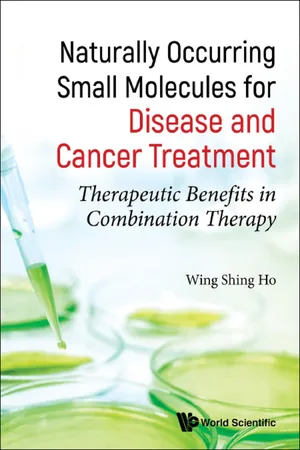
Naturally Occurring Small Molecules for Disease and Cancer Treatment
Therapeutic Benefits in Combination Therapy
- 172 pages
- English
- ePUB (mobile friendly)
- Available on iOS & Android
Naturally Occurring Small Molecules for Disease and Cancer Treatment
Therapeutic Benefits in Combination Therapy
About this book
Western drugs and target medicines for disease treatment come with undesirable side effects that have limited their use in patients for an extended period of time. It is warranted to develop a treatment strategy with alternative medicines to reduce toxicity relating to drugs, in particular, cancer drugs. Thus, a combination therapy with herbal medicines provides a more effective treatment method for hard-to-treat diseases. The recent breakthroughs in naturally occurring small molecules from herbal medicines have provided experimental evidence and are clinically significant in treatment strategies.
This unique volume presents the recent developments in the field of herbal medicines for the treatment of diseases and cancer. Recent progress on small molecules isolated from herbal medicines that exhibit therapeutic benefits in humans is highlighted. The book provides an overview of the significant discoveries and pioneering contributions of herbal medicines in combination with other drugs; the author's evaluation of the combination therapy in cancer treatment; and a recent discovery of crocodile tissue extract with pharmacological properties.
Contents:
- Principles of Pharmacology of Cancer Drug Treatment
- Plant Molecules
- Herbal Medicines
- Therapeutic Uses of Small Molecules
- Mechanism of Action
- Integration and Control of the Human Body During Treatment
- Cytotoxic Plant Molecules and Immunopharmacology
- Potential Beneficial Effects of Plant Products
- Adverse Drug Reactions
- Treatment of Cancer with Natural Products
- Pharmaceutical Development of Potential Cancer Drugs
Readership: Medical students, researchers in medicinal chemistry, pharmacologists and both undergraduate and postgraduate students in pharmacology and those working in herbal and alternative medicine.Therapeutic Benefits;Integrated Medicine;Anti-Cancer;Anti-Inflammatory;Small Molecules;Cancer Treatment;New Drugs;Combination Therapy;Natural Plant Products;Crocodile Tissue Extract0 Key Features:
- The book is unique in providing useful information for treatment of cancers and other diseases
- It is the first time that crocodile tissue extract has been shown to produce health benefits in humans
- Small naturally occurring molecules from herbal medicines provide insight into new drug development
Frequently asked questions
- Essential is ideal for learners and professionals who enjoy exploring a wide range of subjects. Access the Essential Library with 800,000+ trusted titles and best-sellers across business, personal growth, and the humanities. Includes unlimited reading time and Standard Read Aloud voice.
- Complete: Perfect for advanced learners and researchers needing full, unrestricted access. Unlock 1.4M+ books across hundreds of subjects, including academic and specialized titles. The Complete Plan also includes advanced features like Premium Read Aloud and Research Assistant.
Please note we cannot support devices running on iOS 13 and Android 7 or earlier. Learn more about using the app.
Information
Introduction
| Family | Species | Saponins | Cancer | Ref. |
|---|---|---|---|---|
| Agavaceae | Agave utahensis | Chlorogenin hexasaccharide | HL-60 | Yokosuka et al.2, Xu et al.3 |
| Alliaceae | Allium macrostemon Bunge | Macrostemo-noside O, P, Q, and R | HepG2, MCF-7 | Yang et al.4 |
| Aslepiadceae | Cynanchum auriculatum | Wilfoside C3N | A549 | Liu et al.5, Kim et al.6 |
| Asparagaceae | Asparagus gobicus | Asparanin A | HepG2 | Yang et al.7, Wang et al.8 |
| Dioscoreaceae | Disscorea | (25S)-spirost- 5-en-3β | L929, HeLa | Liu et al.9, Gonzalez et al.10 |
| Dracaenaceae | Nam ginseng | Namonins | HT-1080, BL6 | 11, Tran et al.12 |
| Liliaceae | Polygonatum sibiricum Camassia cusickii | Neosibirico-sides A-D TGHS-1 and 2 | MCF-7 P388 | Sy et al.13, Ahn et al.14 |
| Solanaceae | Solanum torvum Solanum indicum L. | Torvosides M Dioscin | HepG2, MCF-7, Colo-205, HSC-2, human fibroblasts | Nartowska et al.15, Lu et al.16 |
Sesquiterpene
Flavonoids
| Flavonoid Subclass | Dietary Flavonoids (aglycones) | Some Common Food Sources |
|---|---|---|
| Anthocyanidins | Cyanidin, Delphinidin, Malvidin, Pelargonidin, Peonidin, Petunidin | Red, blue, and purple berries; red and purple grapes; red wine |
| Flavan-3-ols | Monomers (Catechins): (+)-Catechin, (−)-Epicatechin, (−)-Epigallocatechin, (+)-Gallocatechin; and their gallate derivatives | Teas (white, green, and oolong), grapes, berries, apples |
| Dimers and Polymers: Proanthocyanidins# | Apples, berries, cocoa-based products, red grapes, red wine | |
| Theaflavins, Thearubigins | Black tea | |
| Flavonols | Isorhamnetin, Kaempferol, Myricetin, Quercetin | Onions, scallions, kale, broccoli, apples, berries, teas |
| Flavones | Apigenin, Luteolin, Baicalein, Chrysin | Parsley, thyme, celery, hot peppers |
| Flavanones | Eriodictyol, Hesperetin, Naringenin | Citrus fruit and juices, e.g., oranges, grapefruits, lemons |
| Isoflavones | Daidzein, Genistein, Glycitein, Biochanin A, Formononetin | Soybeans, soy foods, legumes |
Phytochemicals from cruciferous vegetables
Table of contents
- Cover
- Title page
- Other Related Titles from World Scientific
- Copyright
- Table of Content
- About the Author
- Preface
- Acknowledgments
- 1. Principles of Pharmacology of Cancer Drug Treatment
- 2. Plant Molecules
- 3. Herbal Medicines
- 4. Therapeutic Uses of Small Molecules
- 5. Mechanism of Action
- 6. Integration and Control of the Human Body During Treatment
- 7. Cytotoxic Plant Molecules and Immunopharmacology
- 8. Potential Beneficial Effects of Plant Products
- 9. Adverse Drug Reactions
- 10. Treatment of Cancer with Natural Products
- 11. Pharmaceutical Development of Potential Cancer Drugs
- Appendix
- Index